- Преподавателю
- Иностранные языки
- НПК по английскому языку
НПК по английскому языку
| Раздел | Иностранные языки |
| Класс | 7 класс |
| Тип | Тесты |
| Автор | Ахметшина А.Р. |
| Дата | 20.10.2015 |
| Формат | docx |
| Изображения | Есть |
Content.
1. High heels - delusion and reality. (The introduction)
2. High heels cause flatfoot.
3. High heels make shoes uncomfortable.
4. When you walk only on high heels feet get tired.
5. High heels are always harmful.
6. Only the height of heels has the meaning.
7. Orthopedists warn - high heels are unsafe.
8. Choose the right shoes on heels.
9. Rules of wearing shoes. (The conclusion)
-
High heels - delusion and reality.
All little girls want to be like moms, so any mother should expect that soon the baby will be interested in cosmetics, underwear and, of course, shoes on heels. If at the age of 2-3-7 - it is rather funny, but at the age of 10-12 daughters begin seriously to ask high heels.
Every day I paid attention to the shoes of my friends, classmates, teachers and others and I saw that everybody is wearing shoes on heels of a different height: high, medium, low, and some prefer the flat-soled shoes. So I decided to interview the girls and the teachers of my school and find out what kind of shoes they prefer. And whether they know about the danger of high heels, and whether we can walk wearing flat-soled shoes from morning till night without having harm.
There is nothing surprising in the fact that women of a modern city spend most of the working day on high heels. It can't be recalled that high heels have the ability to create the illusion of long legs that has long been considered the standard of female beauty. I am not going to have debates on this topic. High heels align posture, and they are invented to be worn on festive occasions, to give a greater grandeur. But is it worth sacrificing the beauty, which will be inevitably brought the altar? Let's try to understand where is the error, and where the cruel reality is?
High heels add the female growth, make our walk more graceful and feminine, visually lengthen legs and make seductive to shake when you walk by the hips. However, all physicians, especially orthopedists, in a firm voice say that high heels are very harmful! High heels is an absolute harm.[8]
This is true, especially when talking about children's and teenagers' shoes. Where the bone has not matured, the skeleton is continuing the formation and the muscular corset is also formating, shoes should be chosen with utmost care so as not to cause deformation of the foot of the spine. When teenage girls wear shoes on high heels, the load is distributed quite differently-it begins to act on other muscle groups than a normal shoe, the result may develop scoliosis. [7] But not only high heels may bring harm to the foot of a child or a young person, but also too narrow or short shoes may bring harm to us.
When wearing heels the elders may have large health problems too. Walking on high heels implies a shorter step, increases the load on the lumbar spine, in contrast of walking in ordinary shoes. As a result, a blood supply of pelvis is getting worse, it occurs gynecological problems. Gynecologists recommend women who have diseases to switch to low-heeled shoes, or at all, without a heel. When walking on the heels the load increases on the cervical-thoracic part, as a result, if a woman has osteochondrosis of the spine it can occur bad headaches. No wonder, neurologists and orthopedists "shoot" their patients on heels.[8]
-
High heels cause flatfoot.
Actually, among the reasons leading to the development of this pathology, the first is heredity, on the second - chronic and acute diseases that cause damage of the structure ligaments. Obesity, causing a significant increase in the load on the arch of the foot, also appears as one of the causes of flatfoot. This list of shoes is one of the last places, but it plays a significant role, because the load on the foot, when walking on heels, also increases. According to some doctors, wearing shoes on high heels leads to growing of a bone in the big toe joint, with subsequent deformation of the foot.
You should know that it increases the strain on the veins. If you walk on high heels your feet, first of all, your calves are tired, then the fact is that the veins have too high loading, and this can lead to varicose veins, thrombophlebitis, etc.
Girls frequently put on christian louboutin on sale, strolling position whenever putting on high heel shoes purposely or subconsciously, to correct, actually off the high heels, walking fairly more personable feel. And, ladies put on high heel shoes, the legs are very couple of fat, slender and delightful. These are typically difficult wear high heel shoes honed. God female's favorite, in large part, reflected in the high heel shoes upon. When there is no high heel shoes, just like a sentence no verb. [2]
High heel shoes, feminine talent may own curve, the perfect deductions: abdomen, upper body, stylish, waistline if it weren't for that high-heeled shoes, not really conceivable, the woman the way the side walk side to accomplish these challenging motion. New research shows that individuals pick the incorrect shoes, the heel is simply too high, such as the option or even select slip-ons or flip flops, after that weaker to the issue of foot discomfort after a few years. [3] The research also demonstrated that the feet discomfort felt by the actual men and women of different, due to the fact the type of women associated with men's shoes is not the same.
-
High heels make shoes uncomfortable
It is true, but not in all cases. Comfortable or uncomfortable shoes are because of boottreets, which should, ideally, distribute the load across the surface of the sole. If not, the shoes will cause problems regardless of the height of the heel and even of its full absence. Regular customers of workshops, which produce high-quality footwear on individual orders, are dancers, who differ remarkably respecting their own feet, after all it is their working tool.
Recommended heel height is from 2 to 5 (max 7) santimetres. In this case, it is possible to have the right distribution of loading on the bones of the skeleton and the muscles supporting the skeleton. As it's already mentioned, high-heeled shoes are not for daily wearing. And if such footwear is worn only on exceptional cases, the harm of shoes on high heels can be minimized. [1]
-
Feet get tired when you walk only on high heels
It is not so. If you spend all day on your feet, legs get tired, even if you will be comfortable shoes without heels. In order to minimize fatigue of the muscles of the arch of the foot, it is recommended to change shoes during the day for several times, and different models of shoes should have a different heel height. This alternation allows you to offload some groups of muscles and ligaments on the other, which leads to less fatigue.
High heels can be a girl's best friend-helping you to stand up taller, look slimmer, and feel more confident. However, walking in sky-high heels can be a little tricky, especially if you're not used to it. [4] Don't worry though, learning to walk fearlessly in high heels just takes a little practice. Follow these helpful tips and you'll be strutting like a catwalk model in 5-inch stilettos in no time!
Using high heels for long can be quite detrimental for the body. It causes a major impact on the calf muscles and flattens the arch of the foot resulting into chronic postural problems. This also affects the normal structure of the body which disrupts its usual posture. Women who try wearing heels for the first time suffer from foot pain and discomfort while walking. When I wore high heels for the first time, my feet got tired after some time as I was not into the habit of walking in it. This is an issue which is quite common and must have surely affected most women. The effect of high heeled shoes on the body can be grave leaving the muscles affected in some major areas.
During pregnancy, it is necessary for women to take immense care of their health. There is a change in the posture of the body that requires maintaining proper balance. However, walking on high heels does not ensure safety as the ligaments on the lower back as well as muscles gets stretched due to the increased ovarian. In fact, this is a common question that most women ask: whether it is suitable to wear high heels during pregnancy? I often tell them that ligaments of the body at this time are already weakened. Hence these are at a greater risk of getting damaged due to stretch caused by high heeled shoes. [3] This creates excess strain which can lead to complications and serious consequences.
-
High heels are always harmful
There are times when orthopedists recommend that patients' shoes with high heels occur in cases hypoplasia of the vertebral curves. [2] So pathology heels can significantly reduce the load on the spine and ligaments. But such footwear should be selected only on the advice of a doctor, the doctor will advise the necessary height of the heel.
Is it harmful to wear high heeled shoesIt always going to be bad to wear them constantly, but for some people they can be more harmful than others. If you have any form of back or knee problem, they can definetely aggravate it. You also have to bear in mind that its far easy to trip or twist an ankle in heels, particularly stilettoes, and if you find yourself in the unfortunate position of being followed in a deserted alley. You severely restricted your chances of running away (apparently escort agencies recommend their girls always wear a heel below 2 inches and with a secure ankle strap for this reason!). [5] Funnily enough, some back specialists suggest that wearing flat heels constantly is as bad as wearing high ones- the best advice is to vary your heel heights over the course of your week.
Evenly balanced, fairly straight heels or wedges that support the foot tend to be better than skinny stilletoes for walking comfortably in. As already said, it is harmful if the shoes do not fit well or are too high. I always wear heels and I run around all day in them (I rarely get to just sit at my desk). My grandmother wore the most fashionable shoes available in the 40s and she ended up pigeon toed and crippled by it.The best rule of thumb is to wear shoes that allow you to walk somewhat naturally. [4] If a praticular pair of heels causes you to have lower calf strain while walking. If the heels cause you to walk in a stiff manner, you could be doing damage to your back and knees. Use your best judgment when choosing high heeled shoes. I try to wear them every other day instead of every day to minimize the damage. Hope this helps.
-
Only the height of heels has the meaning.
No, the stability of the shoe is determined not only by height, but also the thickness of the heel. In order to walk comfortably you need to replace studs heel shall not be less than four square centimeters. [6]
What can you do? To sacrifice health for the sake of beauty, or vice versa? When is it safe for the teenager to buy high-heeled shoes without causing any harm for his health? It should be clearly aware that a child under 10 years is recommended heels no more than 1.5 inches. High heels can bring real harm to the body of the child, tired legs and downs are only the tip of the iceberg.
Of course, nothing terrible will happen if a girl walks in mom's high heel shoes along the corridor, but no more. Girls aged 10-14 years can buy footwear of higher heels to 2 centimeters and only after 14 years it makes sense to pay attention to the shoes with the heel 4 cm. Higher heels are not recommended as a minimum to 17-18 years, and for continuous wear high heel is not suitable to 23-25 years. [1] The formation of human bones has not completed yet.
We must understand these recommendations and don't go to extremes. If a girl at the age of 17-20 years will wear high heels once a week or on any other occasion, then, of course, nothing terrible will happen. But for the daily wearing her shoes must be desired on a lower heel, no more than 4-5 inches.
-
Orthopedists warn - high heels are unsafe.
Podiatrists agree that a low heel of 1-1,5 cm is not only permissible, but desirable. [3] But high heels can lead to disastrous consequences, which are particularly dangerous for children.
The high heel makes the girl go in small steps, which increases the load on knees joints, and constant wearing of shoes with high heels leads to a change in location angles of ankle and knee joints. All of this is an increased risk of damage to the joints and background to the development of such diseases as osteoarthritis. The hip joints and lumbar spine also suffer from the load. Excessive lumbar curve, inevitable with frequent wearing shoes with heels, leads to deterioration of blood supply to the pelvic organs. This can cause inflammation, problems with conception and child bearing.
Indeed, the problems relate to high-heel mania are legion. Among the issues some women may develop are a shortening and tightening of the Achilles tendon, which may prohibit a woman's ability to wear flat shoes. Tendonitis, pinched nerves, bunions, hammertoes or metatarsalgia, an inflammation of the bones in the ball of the feet, are also problems associated with the sky-high heel, explains podiatrist Jeffery Alexander, assistant professor at Rush University Medical Center in Chicago. Let's not forget the truly unattractive "pump bump," which happens when back of the shoe rubs against the heel bone, causing it to swell. And, of course, there's always the potential for fractures or sprains among "even the most seasoned" high heel wearer, he says.
Currently, diagnosis of foot or ankle pain is made by taking a medical history, performing a physical exam and looking for abnormalities on plain, two-dimensional X-rays, says Mr. Ostankov the Moscow Clinic's professor, which is generally enough to get to the root of the problem. [3] CT scanning, which has been available for many years, is used only when necessary due to its expense and the higher radiation dose.
Doctors are realists when it comes to the high heel. "If a woman wants to wear really high heels on weekends or a night out or even at work because they make her look good, she's going to wear them," says Ms. Vikhrova, the chief of podiatry at st. Petersburg's State's Medical Center. [2] "Fashion is going to win, so I think the message needs to be just don't wear them all the time and for everything that you do."
Even the dreadful looking CT scan of Ms. Vikhrova's own foot isn't making her chuck her heels anytime soon. "I really only wear them on weekends," says Irina Vladimirovna, who is 26. "I think I'll be fine when I'm older." Spoken like someone who has yet to buy an orthotic, or a nice, sensible pump. [2]
You should fully understand that even if a girl is 14-15 years old, and she looks like an adult, her body is still be formed, and therefore, its formation can be broken. So, feet continue to grow until the age of 15-16 years, and the growth of spine ends to form only at the age of 25 years old.
-
Choose the right shoes on heels.
It has been already mentioned that shoes should not be slippery. The fact that the habit of walking on the heels does not appear immediately, and slippery soles may cause fallings and injuries. The same applies to the stability of the heel.
Shoes must be lightweight and can fit in size and fullness. Close or shoes "with reserve" are always undesirable, but for heels they are simply unacceptable. And finally, you should ensure that you wear suitable lifting shoes, because sometimes it happens that shoes with a heel height of 2-3 centimeters are impossible to wear because of the inconvenient position of the legs and sometimes in shoes of 12-centimeter heels you feel like in sneakers.
Now, I suggest you answer the questions I asked in my school, and compare the results. Raise your hands those
- who daily wears high-heeled shoes of 7 cm and more
- who likes to wear ballet flats every day (flat-soled shoes)
- whose casual shoes have heels up to 5 cm
And so, we see that most of us prefer shoes with heels up to 5 cm. At my school 90 people were interviewed, 23 teachers and 67 students of middle and senior classes. The results showed that 6 people like and wear high heeled shoes, among them 5 teenagers; 23 people daily wear ballet flats, 22 schoolgirls and 1 old teacher, and the others 59 participants prefer shoes with heels up to 5 cm
So we can conclude that the majority of respondents wear shoes on an average heel and only few of them are sacrificing their health and want to be on top every day. Though, the flat-soled shoes are very popular.
It turns out that according to experts, the flat-soled shoes are not entirely harmless to the health of the feet. Recent researches in the field of medicine have shown that a lack of heels can cause harm to the spine as well as heels or studs.
Therefore, constant wearing of comfortable sandals at the first sight, summer sandals or ballerinas, according to the doctors, can lead to many diseases of the feet, the first symptom is a pain in the joints, back pain, spinal deformity and arthritis. However, it is not clear why this happens?
The fact that the feet are like a vault or arch, which allows you to bounce when walking. However, the abuse and the frequent use of shoes flat shoes foot is gradually deformed, becomes flat. The arch of the foot, without further recovery, and in the vessels of the legs circulation. Then there is a disturbance of posture, chest drops, and eventually begin to inflamed joints, there is a strong pain. [6]
When wearing shoes without heels and flat shoes it impairs gait. Often it begins to look like as the elderly. In such shoes, the feet are deployed inside and ligaments and tendons in the legs arestretched. The first sign of irreversible changes which appears is a pain, especially in the area of the thumb.
The flat-soled shoes remain relevant. Moreover, the range of such footwear is present for every season. But the flat-soled shoes are harmful for constant wearing. [6] The best shoes from the point of view of specialists are classic men's shoes. It turns out that our men wear the correct shoes.
Proper shoes must be with heels of 2-4 cm. No less important area of the heels is 2-4 cm. is normal, according to orthopedists. A small heel and supports the arch of the foot in the desired position. Up to a maximum of 30 years of age - 2, 5 hours are safe for walking wearing shoes without a heel, from 30 to 40 years 1.5 to 2 hours are safe, and people over 50 shouldn't wear flat soled shoes.[1]
In order to improve the situation slightly, use special orthotics. They properly distribute the load on the foot even in the wrong shoes.
Then, what kind of shoes you can wear, if the flat-soled shoes bring no less harm than high heeled shoes, and heels? Don't we need to go barefoot?
Really, high heels mustn't be carried away and flat shoes only be worn. When choosing shoes, any of them, you should put orthotics. There will be no damage of it, but the benefits are clear. The fact that these insoles will help to evenly distribute the load on the spine and feet.
In general the ideal experts call shoes small - 2-4 cm heel height and the same number in a square area. Any heel higher, lower, wider or narrower, is no longer able to support the arch of the foot in the optimal and harmless position. In addition, the maximum time which is harmless to wear shoes, flat shoes is just two hours. However, people aged over 50, are generally not recommended at all to wear shoes without heels.
9. Rules of wearing shoes.
I want to say to all women, young women and girls that our gait is beautiful only when we walk in comfortable shoes. If you choose the right shoes for wearing them from morning till night, the body will not suffer. [5]
Rule 1. Refrain from constant wearing of heels! You can get in fine boats on the "stud" to work, and change for comfortable shoes with low heels. You can do the opposite if you want to look your best.
Rule 2. Going for a walk or a date on the heels, don't forget to take an extra pair of light ballet flats. When you feel your legs tired and begin to swell, change your shoes calmly and continue to have fun.
Rule 3. If your day involves constant exposure to the heels, at least once an hour arrange the legs a rest: you need to sit down, to take off shoes and pull the toe of the feet. The circulation will be restored.
Rule 4. In the evening, coming home, the first thing is to arrange for legs a medical bath. Pour into a bowl some warm water, add bubble bath or massage oil, dip your feet and enjoy the rest of 15 minutes. It is also useful to do a little foot massage.
Rule 5. The effect of this bath will greatly increase if after that your legs are rubbed with a piece of ice, made from a decoction of medical herbs.
Rule 6. Moving on heels, discipline yourself to keep your back straight and head held high. Only a proud posture and impeccable gait can justify your suffering from wearing high heels. [7]
A few more tips:
- Do not skimp on shoes: buy only high - quality comfortable shoes made of natural leather.
- Refrain from wearing them, if you drive a car: it is very dangerous!
- Do not wear high heels if you suffer from a disease of the feet.
In conclusion, I'd like to say that we shouldn't forget about an important middle ground, and everything in moderation is good. If we think not only about our beauty but also our health, such reasoning will save us from choosing inconvenient and not practical shoes of very high heels. If, nevertheless, necessity compels us to wear shoes with very high heels, you must take house shoes to work or an event for change, and coming home we must pay attention to our tired legs. It is necessary for the legs to have a tub with warm water, a cold shower, a brush with a nourishing cream. It is necessary to give the feet an elevated position for blood to flow and release a tension.
Take care of yourself and be healthy!
Bibliography.
-
Interactive guide to the anatomy. Atlas of the human body for grades 5-11. 2007.
-
Nasonova C. A., Goltaeva N. G. International decade of diseases of bones and joints // Therapeutic archive. 2010. No. 5. C. 5-7.
-
Volkov, A. I. Gusev, E. I. and others. The most common disorders of the musculoskeletal system in Russia Scientific-practical rheumatology. 2011. No. 2. C. 4-8.
-
osteopathic.org/osteopathic-health/about-your-health/health-conditions-library/womens-health/high-heels.aspx.
-
sheknows.com/health-and-wellness/articles/845251/are-your-high-heels-hurting-your-health.
-
drbenkim.com/articles-healthyfeet.html.
-
huffingtonpost.com/neal-m-blitz/high-heel-foot-injury_b_1622464.html.
-
susansaies.hubpages.com/hub/Wearing-High-Heels.
Appendix
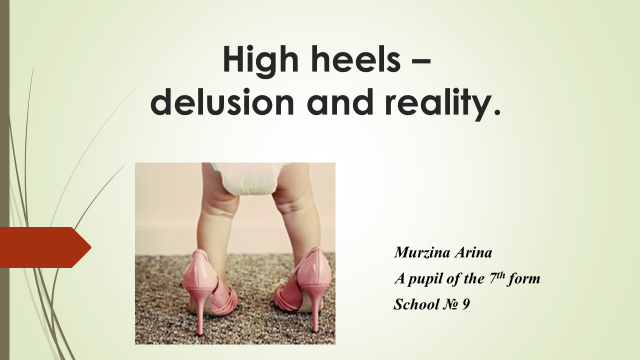

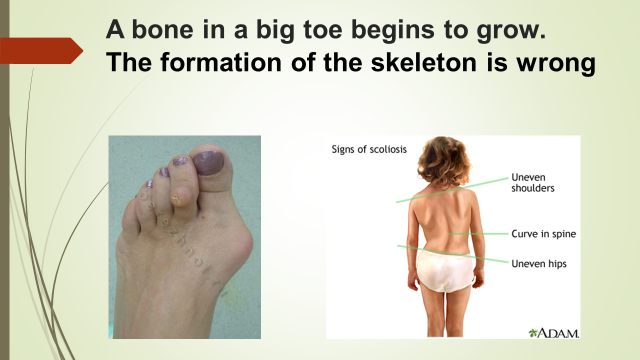
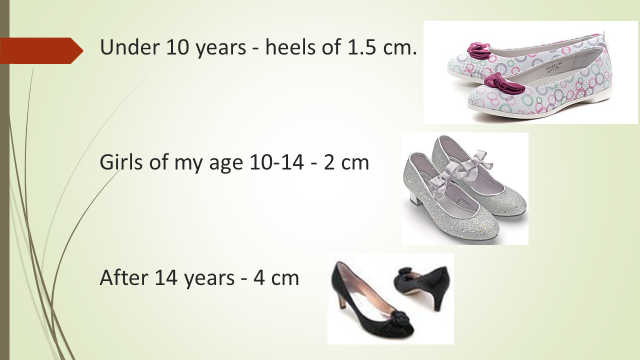
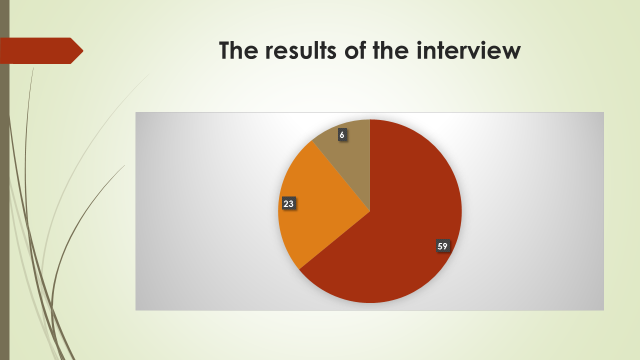
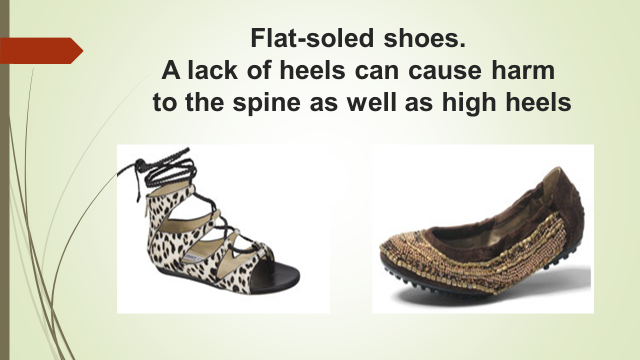
14


